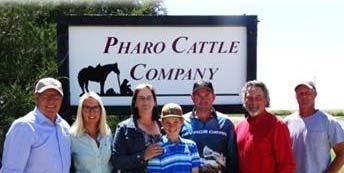
3 minute read
International Partnership
Pharo Cattle Company (PCC) has been a no-nonsense, grass-based seedstock producer in the United States for over 30 years. While the status quo beef industry was hell-bent to increase production per animal, PCC was focused on increasing production and profit per hectare. There is a BIG difference! Focusing on production per animal may create bragging rights — but it will always have a negative effect on profit. The status quo beef industry — around the world — has been focused on the wrong thing for over 40 years. As the industry succeeded in increasing production (and size) per animal, production and profit per hectare decreased. It doesn’t matter how big your cattle are if they are not profitable. We have concluded the most profitable cows, in nearly all environments, are thick, easy-fleshing, moderate-sized, early-maturing, low-maintenance cows — cows that can wean 50% of their own weight on a year-round, all-grass diet. These low-input Solar Cows make it possible to increase stocking rate (production per hectare), while decreasing cost of production. In the last 30+ years… Pharo Cattle Company has grown from a never-heard-of seedstock producer with a lot of unconventional ideas to one of the largest seedstock producers in America. We are currently selling over 1000 grass-developed bulls per year. The status quo beef industry still doesn’t agree with us — but we are okay with that. Pharo Cattle Company is proud of the fact that we have helped thousands of cow-calf producers in America increase their profits by 50 percent to over 200 percent. To a lesser extent we are doing the same thing in Canada, Mexico, South Africa and Australia. Our goal, from the very beginning, has been to help ranchers put more fun and profit into their business. In 2016, Pharo Cattle Company started visiting with the people from Furracabad Station in NSW about the possibility of creating a program similar to PCC in Australia. The more we talked about it, the more excited everyone became. That prompted us to form an international partnership with Furracabad Station called Pharo Cattle Australia (PCA).
Furracabad Station...
Advertisement
Furracabad Station is owned by Geoff Putland. Geoff is a businessman first — and a cattleman second. This allows him to look at the business of ranching much differently than most ranchers. Ryan and Kate Usmar take care of the day-to-day management decisions. For many years… Geoff, Ryan and Kate had been greatly frustrated by the limited amount of profit produced by status quo ranching. The return on investment was terrible! The bulls they purchased were unable to do six weeks’ worth of work before falling apart. Using bulls that were unable to perform on an all-grass diet created cows that were unable to perform on grass alone. In May of 2015, Ryan and Kate heard Kit Pharo speak at Beef Week in Rockhampton. They were intrigued and excited by what they heard. Ryan was so intrigued, he attended another meeting five days later that Kit spoke at. They had finally found many of the answers and solutions they had been looking for. Furracabad Station has always pushed their cows hard. They let the environment sort out the good ones, while they showed absolutely no sympathy for open, late or dry cows. They also have no tolerance for cows with bad dispositions, bad udders or structural problems. In addition to all of this, they cull all animals that require assistance at calving. If you really want to put your cowherd to the test, shorten your joining season. For several years, Furracabad Station has only had a 45-day joining season for their cows and a 25-day season for their heifers. Heifers are developed on grass. They are joined at 14 months of age — and are expected to calve unassisted at two years of age. Furracabad Station has purchased several of Pharo Cattle Company’s very best Angus and Heat-Tolerant Composite bulls. Since live bulls cannot be imported by Australia, they sent the bulls to collection centers in the US. They collect 5000 units of semen on every PCC bull. This is exported to Australia for use on their cows. They AI breed a high number of cows every year.



